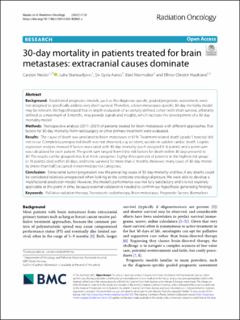| dc.contributor.author | Nieder, Carsten | |
| dc.contributor.author | Stanisavljevic, Luka | |
| dc.contributor.author | Aanes, Siv Gyda | |
| dc.contributor.author | Mannsåker, Bård | |
| dc.contributor.author | Haukland, Ellinor Christin | |
| dc.date.accessioned | 2023-01-05T12:42:03Z | |
| dc.date.available | 2023-01-05T12:42:03Z | |
| dc.date.created | 2022-10-19T15:18:53Z | |
| dc.date.issued | 2022 | |
| dc.identifier.citation | Nieder, C., Stanisavljevic, L., Aanes, S. G., Mannsåker, B., & Haukland, E. C. (2022). 30-day mortality in patients treated for brain metastases: extracranial causes dominate. Radiation Oncology, 17(1), 1-7. | en_US |
| dc.identifier.issn | 1748-717X | |
| dc.identifier.uri | https://hdl.handle.net/11250/3041245 | |
| dc.description.abstract | Background
Established prognostic models, such as the diagnosis-specific graded prognostic assessment, were not designed to specifically address very short survival. Therefore, a brain metastases-specific 30-day mortality model may be relevant. We hypothesized that in-depth evaluation of a carefully defined cohort with short survival, arbitrarily defined as a maximum of 3 months, may provide signals and insights, which facilitate the development of a 30-day mortality model.
Methods
Retrospective analysis (2011–2021) of patients treated for brain metastases with different approaches. Risk factors for 30-day mortality from radiosurgery or other primary treatment were evaluated.
Results
The cause of death was unrelated to brain metastases in 61%. Treatment-related death (grade 5 toxicity) did not occur. Completely unexpected death was not observed, e.g. accident, suicide or sudden cardiac death. Logistic regression analysis showed 9 factors associated with 30-day mortality (each assigned 3–6 points) and a point sum was calculated for each patient. The point sum ranged from 0 (no risk factors for death within 30 days present) to 30. The results can be grouped into 3 or 4 risk categories. Eighty-three percent of patients in the highest risk group (> 16 points) died within 30 days, and none survived for more than 2 months. However, many cases of 30-day mortality (more than half) occurred in intermediate risk categories.
Conclusion
Extracranial tumor progression was the prevailing cause of 30-day mortality and few, if any deaths could be considered relatively unexpected when looking at the complete oncological picture. We were able to develop a multifactorial prediction model. However, the model’s performance was not fully satisfactory and it is not routinely applicable at this point in time, because external validation is needed to confirm our hypothesis-generating findings. | en_US |
| dc.language.iso | eng | en_US |
| dc.publisher | Springer Nature | en_US |
| dc.rights | Navngivelse 4.0 Internasjonal | * |
| dc.rights.uri | http://creativecommons.org/licenses/by/4.0/deed.no | * |
| dc.title | 30-day mortality in patients treated for brain metastases: extracranial causes dominate | en_US |
| dc.title.alternative | 30-day mortality in patients treated for brain metastases: extracranial causes dominate | en_US |
| dc.type | Peer reviewed | en_US |
| dc.type | Journal article | en_US |
| dc.description.version | publishedVersion | en_US |
| dc.rights.holder | The author | en_US |
| dc.subject.nsi | VDP::Medisinske Fag: 700 | en_US |
| dc.source.volume | 17 | en_US |
| dc.source.journal | Radiation Oncology | en_US |
| dc.source.issue | 1 | en_US |
| dc.identifier.doi | 10.1186/s13014-022-02062-x | |
| dc.identifier.cristin | 2062909 | |
| cristin.ispublished | true | |
| cristin.fulltext | original | |
| cristin.qualitycode | 1 | |

